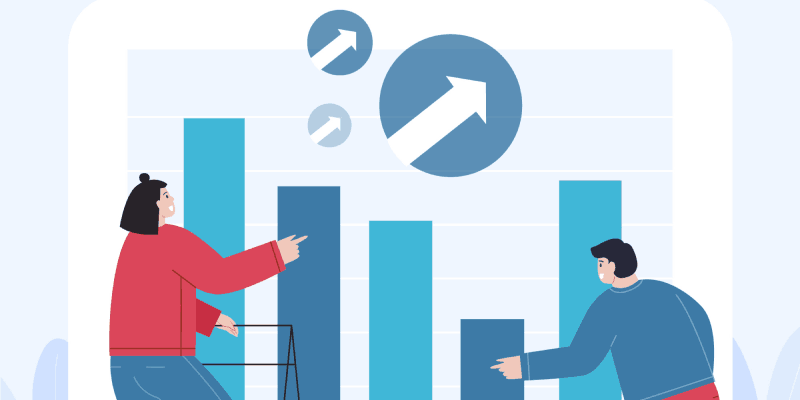Customer Churn Rate: Definition, Formulas and Benefits

Although customer churn, losing some customers over time, is perceived as inevitable in certain cases, it is also undesirable among companies. However, every business experiences churn, regardless of its size, quality of customer service and the product itself.
What’s important is how your company responds to churn, whether you fully understand why it happens, and what you can do to prevent it.
In order to be able to reduce the customer churn rate, you first must understand how to calculate and analyze the churn rate. This is the topic of this article and we invite you to stay with us and learn a thing or two.
What Is the Churn Rate?
Churn rate, or attrition rate, is a natural occurrence in business, where some customers simply decide to leave your company for whatever reason, while others, which is customer acquisition or customer retention, decide to try out your product or stick to it for a long time.
In SaaS, churn mainly refers to the customers who cancel or don’t renew their subscriptions. The churn rate shows the percentage of lost customers over a certain time period, usually monthly or annually, but you can calculate customer churn daily if you wish. This essential metric can clarify a company’s shortcomings and help you identify areas for improvement, and the lower the churn rate, the better.
How to Calculate Customer Churn Rate?
To improve the customer experience, increase customer retention, and reduce churn, it is essential to understand how to calculate the customer churn rate.
Besides the customer churn rate formula, there are two other common ones, the gross revenue churn rate and the adjusted churn rate, that can help you get more precise information on churn.
Customer Churn Rate
It is as simple as it gets yet an essential KPI to measure. You first need to define the desired time period, then subtract the number of customers lost during that time period from the customers at the start of the time period, and multiply it by 100 to get the percentage.
Here is the formula:

Adjusted Churn Rate
Businesses that grow rapidly and experience both high churn and a substantial increase in new customers should apply a more complex formula like this one:

The average monthly churn rate for subscription services or subscription churn, goes from 5% to 7%, which means that this percentage typically cancels their subscriptions each month.
What are the Benefits of Analyzing Customer Churn?
There are multiple benefits to customer churn analysis for SaaS businesses. Besides increasing customer satisfaction and identifying areas for improvement, customer churn analysis can help you optimize marketing and sales efforts and improve product development. As these are all strategies that contribute to customer experience improvement, it is easy to conclude that the main goal and benefit of customer churn analysis is surely a higher customer retention rate.
What is a Revenue Churn?
Revenue churn is lost revenue from existing customers who have canceled their subscriptions within a certain time period. It is one of the most crucial metrics for SaaS, as it shows the direct impact that churn has on the company’s revenue.
How to Calculate the Revenue Churn?
To understand how to calculate revenue churn, let us show you the gross and net revenue churn formulas.
A frequent revenue churn calculation can help you understand the impact of churn on your overall revenue and highlight the best possible strategies to reduce churn and increase customer retention.
Gross Revenue Churn Rate
This metric shows how much revenue you lost in a given time period due to churn. It shows, more precisely, the impact of customer churn on your overall revenue.
First, you need to determine the monthly churned revenue, then subtract it from the monthly recurring revenue in the previous time period, and multiply the number by 100.

Net Revenue Churn Rate
Net Revenue Churn Rate measures the percentage of recurring revenue lost after factoring in revenue gained from existing customers upgrading or buying add-ons. It shows the health of your customer base’s revenue contribution.
Here is the formula:

Customer Churn Rate vs. Revenue Churn Rate
Customer churn rate and revenue churn rate are closely related but distinct metrics that provide valuable insight into the influence of churn on a SaaS business.
Customer churn rate shows the percentage of lost customers within a given time period, while revenue churn rate shows the lost revenue from existing customers who have churned within a specific period.
Conclusion
How you respond to negative life circumstances defines the quality of your life — the same rule applies to churn. If you manage to understand the reasons that hide behind the churned customers and use them to empower your business strategies and products, you are one step closer to reducing churn and improving customer retention.
To effectively reduce the customer churn rate, make sure to focus on improving the customer experience, investing in customer success, and targeting an adequate audience. Use Akita to segment your customers, understand them better, and create customized offerings and messaging to motivate them to continue using your platform and making the most of it.
Frequently Asked Questions
What is a good customer churn rate?
A good customer retention rate can vary from industry to industry, yet a rate of around 5% or lower (monthly churn) is perceived as good for SaaS businesses.
What is a 1% churn rate?
A 1% churn rate means that 1% of your current customers have canceled their subscriptions within a certain time period. This rate is extremely low and indicates high customer retention, as the majority of your customers are happy with your platform and are likely to continue using it.
How do you calculate the customer churn rate?
You can use the customer churn formula we provided in the article above.








